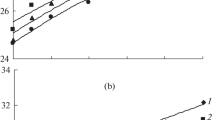Abstract
Viscosity behaviour of several samples ofGraham's salt with varying molecular weight has been studied. Reduced viscosity (η sp /c) versus concentration curves were found to be characteristic of polyelectrolytes. They are dependent on the molecular weight and can be reduced to straight lines by plotting the reciprocal of the reduced viscosity against the square root of concentration. The intrinsic viscosities obtained by extrapolation were found to be proportional to the square of molecular weights. The value of reduced viscosity at any particular concentration in the concentration range between 0.25% and 4.0% was linearly related to the molecular weight.
Reduced viscosities were found to decrease considerably on addition of electrolytes. Reduced viscosity versus added salt concentration curves were remarkably molecular weight dependent. The pH of the medium seemed to have no effect at all. Bivalent salts reduce the viscosity to a much greater extent than monovalent ones. By keeping the concentration of the added salt constant and varying that ofGraham's salt, curves showing hump which disappeared at higher concentration of the added salt, were obtained. In the action of electrolytes the more important factor is the valency of cation rather than the ionic strength of the medium.
Most observations confirm the already well-establishedFolding-Chain Theory of polyelectrolytes developed byKatchalsky, Fuoss and others.
Zusammenfassung
Das Viskositätsverhalten verschiedener Proben vonGrahamsalz mit variierendem Molekulargewicht wurde untersucht. Die reduzierte Viskosität (η sp /c) gegen die Konzentration aufgetragen, ist charakteristisch für Elektrolyte. Die Kurven sind molekulargewichtsabhängig und können zu einer Geraden reduziert werden, wenn man den Reziprokwert der reduzierten Viskosität gegen die Quadratwurzel der Konzentration aufträgt. Die Intrinsic-Viskosität, durch Extrapolation erhalten, ist dem Quadrat des Molekulargewichts proportional. Der Wert der reduzierten Viskosität für jede Konzentration im Bereich 0,25 bis 4% ist linear im Molekulargewicht.
Die reduzierten Viskositäten sinken beträchtlich bei Zufügung von Elektrolyten. Trägt man sie gegen die Konzentration des zugeführten Salzes auf, so sind die Proben stark molekulargewichtsabhängig. Der pH- Wert des Mediums scheint überhaupt keinen Effekt zu verursachen. Zweiwertige Salze reduzieren die Viskosität viel stärker als einwertige. Hält man die Konzentration des zugefügten Salzes konstant und verändert die desGrahamsalzes, so zeigt sich ein Buckel, der bei höheren Konzentrationen von zugefügtem Salz verschwindet. Für die Wirkung des Elektrolyten ist der wichtigere Faktor eher die Valenz des Kations als die Ionenstärke des Mediums.
Die meisten Beobachtungen bestätigen die schon wohlbekannte Kettenfaltungstheorie für Polyelektrolyte, dieKatchalsky, Fuoss u. a. entwickelt haben.
Similar content being viewed by others
References
Kruyt, H. R., Colloid Science, vol. II (Amsterdam 1949):J. T. G. Overbeek andBungenberg de Jong, p. 184.
Van Wazer, J. R., J. Amer. Chem. Soc.72, 906 (1950).
Strauss, U. P. andE. H. Smith, ibid.75, 6186 (1953).
Strauss, U. P. andP. L. Wineman, ibid.75, 3935 (1953).
Chatterji, A. C. andH. N. Bhargava, J. Polymer Sci. (in press).
Kruyt, H. R. andK. C. Winkler, Kolloid-Beih.32, 374 (1931).
Bungenberg de Jong, H. G. andO. S. Gwan, ibid.31, 89 (1930).
Bungenberg de Jong, H. G. andN. F. de Vries, Rec. trav. chim.,49, 658 (1930).
Bungenberg de Jong, H. G., H. R. Kruyt andJ. Lens, Kolloid-Beih.36, 429 (1932).
Heidelberger, H. andF. E. Kendall, J. Biol. Chem.95, 127 (1932).
Basu, S., Nature168, 341 (1951).
Basu, S. andP. C. Das Gupta andA. K. Sircar, J. Colloid Sci.6, 539 (1951).
Basu, S. andP. C. Das Gupta, ibid.8, 355 (1953).
Basu, S. andA. K. Sircar, ibid.9, 575 (1954).
Basu, S. andP. C. Das Gupta, ibid.7, 53, (1952).
Kern, W., Z. phys. Chem. (A)181, 283 (1938).
Markowitz, H. andG. E. Kimball, J. Colloid Sci.5, 115 (1950).
Pals, D. T. F. andJ. J. Hermans, J. Polymer Sci.3, 897 (1948).
Pals, D. T. F. andJ. J. Hermans, Rec. trav. chim.71, 433, 458 (1952).
Fuoss, R. M., Science108, 545 (1948); Disc. Faraday Soc.11, 125 (1951).
Fuoss, R. M. andU. P. Strauss, J. Polymer Sci.3, 246, 602 (1948);R. M. Fuoss, ibid.3, 603 (1948), correction, ibid.4, 96 (1949).
Fuoss, R. M. andG. I. Cathers, ibid.4, 97 (1949).
Signer, R. andA. Demagistri, J. chim. phys.47, 704 (1950).
Balazs, E. A. andT. C. Laurent, J. Polymer Sci.6, 665 (1951).
Oth, A. andP. Doty, J. Phys. Chem.56, 43 (1952).
Schaefgen, J. R. andC. F. Trivisonno, J. Amer. Chem. Soc.73, 4580 (1951); ibid.74, 2715 (1952).
Chatterji, A. C. andV. K. Kulshreshtha (Unpuplished results).
Von Smoluchowski, M., Kolloid-Z.18, 190 (1916).
Katchalsky, A. andPnina Spitnik, J. Polymer Sci.2, 432 (1947).
Kuhn, W., O. Künzle andA. Katchalsky, Helv. chim. acta31, 1994 (1948).
Hermans, J. J. andJ. T. G. Overbeek, Rec. trav. chim.67, 761 (1948); Bull. Soc. Chim. Belges57, 154 (1948).
Doty, P. andG. Ehrlich, Ann. Rev. Phys. Chem.3, 81 (1952).
Young, T. F. andA. C. Jones, ibid.3, 294 (1952).
Fuoss, R. M. andA. S. Fuoss, ibid.4, 64 (1953).
Katchalsky, A., J. Polymer Sci.12, 159 (1954).
Fuoss, R. M. andW. N. Macley, ibid.6, 305 (1951).
Fuoss, R. M. andD. Edelson, ibid.6, 523 (1951).
Schneider, N. S. andP. Doty, J. Phys. Chem.58, 762 (1954).
Fuoss, R. M. andU. P. Strauss, Ann. N. Y. Acad. Sci.51, 836 (1949).
Schaefgen, J. R., Amer. Chem. Soc. (Chigago Meeting) 1950.
Kruyt, H. R. andH. G. Bungenberg de Jong, Kolloid-Beih.37, 1 (1928).
Kruyt, H. R. andH. J. C. Tendeloo, ibid.29, 396 (1929).
Briggs, D. R., J. Phys. Chem.45, 866, 943 (1941); ibid.48, 1 (1944).
Aten, A. H. W. Jr., J. Chem. Phys.16, 636 (1948).
Dhar, N. R. andR. C. Mehrotra, Proc. National Inst. Sci. India16, 59 (1950).
Van Wazer, J. R., andD. A. Campanella, J. Amer. Chem. Soc.72, 655 (1950).
Chatterji, A. C. andR. M. Bhatnager (Unpublished Results).
Bungenberg de Jong, H. G., H. R. Kruyt andJ. Lens, Kolloid-Beih.37, 395 (1933).
Debye, P., J. Chem. Phys.14, 636 (1946).
Steiner, R. F. andP. Doty, ibid.20, 85 (1952).
Author information
Authors and Affiliations
Rights and permissions
About this article
Cite this article
Chatterji, A.C., Nath Bhargava, H. Studies in inorganic polyelectrolytes — Part II. Kolloid-Zeitschrift 160, 35–44 (1958). https://doi.org/10.1007/BF01512076
Received:
Issue Date:
DOI: https://doi.org/10.1007/BF01512076




